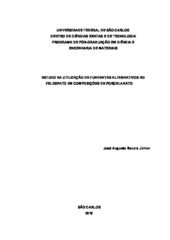| dc.contributor.author | Baucia Júnior, José Augusto | |
| dc.date.accessioned | 2016-06-02T19:11:59Z | |
| dc.date.available | 2010-01-15 | |
| dc.date.available | 2016-06-02T19:11:59Z | |
| dc.date.issued | 2010-01-05 | |
| dc.identifier.citation | BAUCIA JÚNIOR, José Augusto. Study of the use of alternative fluxing agents to the feldspar in porcelainized stoneware tile compositions. 2010. 157 f. Dissertação (Mestrado em Ciências Exatas e da Terra) - Universidade Federal de São Carlos, São Carlos, 2010. | por |
| dc.identifier.uri | https://repositorio.ufscar.br/handle/ufscar/798 | |
| dc.description.abstract | The porcelainized stoneware has been outstanding in the current market of ceramic tiles because it offers excellent technical and esthetic features. In this research traditional ceramic raw materials were selected and a standard formulation reported in the literature was adopted, aiming to replace the vitreous phase former (feldspar) from the composition by two fluxing agents at high temperature. The objective was to evaluate these materials as a technical alternative with lower cost (30-40%), since, in the porcelain, the amount of flux former is very large, and represents approximately 50% of all raw materials used. The nepheline syenite was the natural raw material selected to replace the feldspar due to the fact that it belongs to the family of feldspathoids, and has similar physicochemical characteristics, therefore, high fluxing efficiency. The second vitreous phase former was a synthetic material, named flux agent, with physical and chemical characteristics very different from those of the feldspar and even greater fluxing efficiency. The replacement of feldspar occurred in complete and in part, through combinations of the alternative fluxes. The masses were processed from mixing of powders, wet milling, drying, desagglomeration, compaction and firing. In addition to the curves of vitrification, techniques, as sedimentometry, dilatometry, flexure strength test, electron microscopy, piroplastic deformation measurements and X-ray diffraction were used to characterize the material sintered at different temperatures. The most important results show that it is possible to combine nepheline and synthetic flux as alternative material other than feldspar because they promote vitrification at lower temperatures. Compositions with both fluxes showed low values of water absorption (<0.1%) and high mechanical strength (45 MPa) when compared to the standard, despite of the higher piroplastic deformation. The presence of nepheline does not change qualitatively the formation of phases and the flow generates new crystalline phases, in according to phases diagram. | eng |
| dc.description.sponsorship | Universidade Federal de Sao Carlos | |
| dc.format | application/pdf | por |
| dc.language | por | por |
| dc.publisher | Universidade Federal de São Carlos | por |
| dc.rights | Acesso Aberto | por |
| dc.subject | Porcelanato | por |
| dc.subject | Revestimento cerâmico | por |
| dc.subject | Fundente | por |
| dc.subject | Feldspato | por |
| dc.subject | Nefelina | por |
| dc.subject | Fluxo viscoso | por |
| dc.title | Estudo da utilização de fundentes alternativos ao feldspato em composições de porcelanato | por |
| dc.title.alternative | Study of the use of alternative fluxing agents to the feldspar in porcelainized stoneware tile compositions | eng |
| dc.type | Dissertação | por |
| dc.contributor.advisor1 | Morelli, Márcio Raymundo | |
| dc.contributor.advisor1Lattes | http://genos.cnpq.br:12010/dwlattes/owa/prc_imp_cv_int?f_cod=K4780873E7 | por |
| dc.description.resumo | O porcelanato tem se destacado no mercado atual de revestimentos cerâmicos, pois apresenta excelentes características técnicas e estéticas. Neste trabalho foram selecionadas matérias-primas cerâmicas tradicionais e adotada uma formulação padrão convencionalmente reportada na literatura, visando à substituição da fase fundente (feldspato) da composição por dois tipos de matérias-primas formadoras de fase líquida em alta temperatura. O objetivo foi avaliar essas matérias-primas como alternativa técnica e de menor custo (30 a 40% menor), uma vez que, em massas de porcelanato, a quantidade de fundente representa aproximadamente 50% do total das matérias-primas utilizadas. A nefelina sienito foi a matéria-prima natural substituta escolhida por pertencer à família dos feldspatóides, que possui características físico-químicas semelhantes ao feldspato, portanto, uma elevada fundência. O segundo fundente foi um material sintético, denominado neste trabalho como fluxo, com características físico-químicas bem diferentes e uma fundência ainda maior. A substituição ao feldspato ocorreu de maneira total e/ou parcial, por meio de combinações entre os fundentes alternativos. As massas foram processadas a partir da mistura de pós, moagem a úmido, secagem, desaglomeração, compactação e queima. Além das curvas de gresificação, técnicas como sedimentometria, dilatometria, ensaio de resistência mecânica à flexão a três pontos, microscopia eletrônica, medidas de deformação piroplástica e difratometria de raios X foram utilizadas para a caracterização dos materiais após queima em diversas temperaturas. Os principais resultados mostraram que, a princípio, é possível a combinação das matérias-primas nefelina e fluxo como material alternativo ao feldspato, pois elas proporcionam a gresificação em temperaturas mais baixas. Composições com ambos fundentes apresentaram baixos valores de absorção de água (<0,1%) e elevada resistência mecânica (45 MPa) quando comparadas a padrão, apesar de maior deformação piroplástica. A presença da nefelina não altera qualitativamente a formação de fases e o fluxo gera novas fases cristalinas em acordo com o diagrama de equilíbrio de fases. | por |
| dc.publisher.country | BR | por |
| dc.publisher.initials | UFSCar | por |
| dc.publisher.program | Programa de Pós-Graduação em Ciência e Engenharia de Materiais - PPGCEM | por |
| dc.subject.cnpq | ENGENHARIAS::ENGENHARIA DE MATERIAIS E METALURGICA | por |
| dc.contributor.authorlattes | http://lattes.cnpq.br/7324528391865429 | por |
